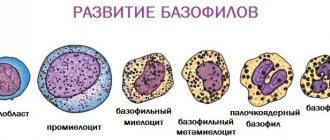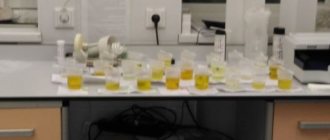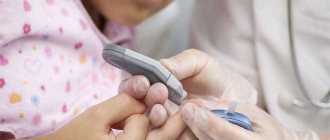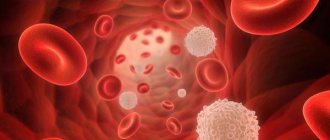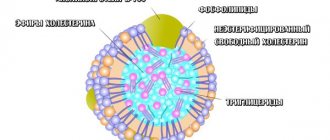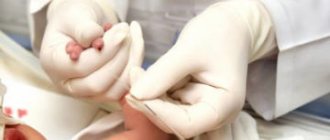What are eosinophils
Very often in pediatrics they encounter allergies in children. In order to identify an allergic reaction to a certain product or find out about bacterial and helminthic infections, the pediatrician prescribes a general blood test. And it is by the level of eosinophils that one can determine whether there is some pathological deviation.
Eosinophils are a type of white blood cell that is responsible for inflammatory processes in the body. Moreover, they are designed to protect the body from toxins and various harmful carriers, such as allergens. Like all blood cells, eosinophils are formed in the bone marrow.
An interesting fact is that it is this type of eosinophils that can “travel,” so to speak, throughout the body, thereby neutralizing some toxin.
What are they responsible for?
These are blood cells, which are one of the subtypes of leukocytes. Together with other forms - neutrophils and basophils, which also contain granules, they belong to the same type - granulocytes. Eosinophils in children and adults are responsible for protecting the body from the negative effects of toxic substances and irritating factors that provoke the development of allergic reactions. Eosinophils react to parasites and some types of pathogenic agents, inflammatory foci.
Cells are produced by bone marrow. After they enter the general bloodstream, they disperse throughout the body, settling in the internal organs and capillaries. A small number of them are present in the peripheral circulatory system. Eosinophils have the ability to quickly move throughout the body due to the amoeboid mode of movement. Thus, the cells themselves find the inflammatory focus or pathogenic microflora, parasites, settle near them and destroy them.
Eosinophils affect not only pathogens, but also foreign particles formed in the body during allergic or autoimmune reactions. If parasites enter the body, these blood cells begin to actively produce substances of an enzymatic nature that destroy the cell membrane of the parasites.
Normal eosinophil count in children
The higher the percentage of eosinophils, the more allergens in the body. It is worth noting that the levels in childhood and adults are different. The purpose of eosinophils is to protect the body. And it is the normal level in the blood that indicates a healthy body.
Optimal content in percentage:
| Child's age | Interest |
| From 0 to 1 year | From 1% to 6% |
| From 1 year to 2 years | From 1% to 7% |
| From 3 years to 5 years | From 1% to 6% |
| From 6 years to 12 years | From 1% to 5.5% |
| From 13 years to 16 | From 1% to 5% |
After 16 years of age, the indicator can already be equated to the adult indicator. With age, the amount becomes smaller. In practice, there have been cases when, after the age of six, the level of eosinophils equated to 0. And then disappeared completely. This is acceptable and is not considered a deviation.
It is worth noting that during the day, the level of eosinophils may change. This occurs due to the functioning of the adrenal glands. And it is at night that the level of eosinophils reaches its maximum. And the lowest percentage is in the morning and evening hours. For this reason, it is customary to take a blood test in the morning and on an empty stomach. This is a prerequisite for a reason, but for a correct and accurate analysis result.
The normal level of eosinophils in the blood of a child
As mentioned earlier, eosinophils do not stay in the bloodstream for a long time. Therefore, healthy children should not have many eosinophils.
The numerical values of the norm depend on the method used to determine the number of cells. In old laboratories, the leukocyte formula is calculated manually, the result is given only in relative values, that is, in %.
Normally, in children under 4 years of age, the relative number of eosinophils should not exceed 7%. Over this age, the norm is the same as for adults - no more than 5%.
In modern laboratories, cells are most often counted automatically on a hematology analyzer, and only in exceptional cases are they counted manually. When counting cells on the analyzer, the result can be given in the form of relative and absolute values.
The absolute number of eosinophils reflects their exact number per liter of blood.
The absolute values of normal eosinophils are presented in the table.
Table. The norm of eosinophils in the blood of children.
| Age | Absolute quantities |
| Up to a year | 0.05 - 0.4 *10*9/l |
| One year - six years | 0.02 - 0.3 *10*9/l |
| More than six years | 0.02 - 0.5 *10*9/l |
Data with normal values are given for informational purposes only; you should not decipher the results of the analysis yourself!
Causes of elevated eosinophils
Reasons for increased eosinophils include:
- Some allergen is developing in the body. And it is the increase in eosinophils that indicates this. As a rule, this is one of the most common causes in children.
- Worms. There is nothing ashamed for parents if a small child is found to have worms. After all, these are children, they taste everything and put every toy in their mouth. No matter how hard mom and dad try to raise their child cleanly, unfortunately, sometimes this happens.
- Various skin diseases. This could be either diaper rash or lichen, which the child could have contracted from an outdoor cat.
- Malignant tumors. This is already in a more severe form of the disease.
- Vascular dysfunction and circulatory system disease.
- Lack of such a useful substance as magnesium in the blood.
Eosinophils in helminthiasis
A common cause of increased eosinophils in children is infection with worms. The presence of helminths in the child’s body is determined using tests:
- feces - diagnostics, with the exception of roundworm and giardia, is not accurate, because it does not detect larvae, waste products, the method does not work if the source of infection is outside the digestive tract;
- blood - general analysis, liver tests;
- ELISA is an enzyme-linked immunosorbent assay that determines the presence of antibodies in the blood to certain types of helminths.
The most reliable way to detect parasites is blood ELISA. This method allows not only to determine the type of helminth, but also to identify the level of infection of the body.
Using ELISA, for example, Toxocara infection is diagnosed. If the titer of antibodies to the antigens of a given type of parasite exceeds 1:800, then the patient is infected and is a carrier of the disease. With ELISA 1: 3200, eosinophils in the child’s blood are increased to 35–40%, and this condition indicates a high degree of helminth infection.
Types of helminthiases
Toxocariasis can occur in children with symptoms of bronchitis and pneumonia. The patient's condition is characterized by cough, fever combined with intestinal upset.
Toxocariasis is caused by the parasitic worms Toxocara. Toxocara larvae travel through the bloodstream into the lungs, eyes, kidneys, and muscles. Adult forms parasitize the intestines.
Toxins that are released during the life of parasitic worms cause an allergic reaction, accompanied by increased eosinophils to 70 - 80% and high IgE.
Signs of toxocariasis are:
- abdominal pain;
- skin rashes;
- enlargement of the liver and lymph nodes.
Eosinophils increase up to 80% in children with tropical eosinophilia. This disease is caused by parasites: nematodes, tapeworms, roundworms, echinococci, and hookworms.
Tropical pulmonary eosinophilia is accompanied by fever, dry cough, and asthmatic breathing. Children are characterized by enlarged lymph nodes and liver. The child loses weight, eosinophils in the blood are increased to 90%, and total leukocytes are high, increased to 50*109/l.
Increased EO during parasitosis
Infection with any of the 98 known species of parasites common in the Russian Federation causes increased eosinophils. Depending on the aggressiveness of the parasite and its quantity in the body, EO can be increased from 7 - 8% to 80 - 90%.
Eosinophils are increased to 12 - 50%, ESR is increased to 8 - 12 mm per hour in opisthorchiasis. The type of parasitosis can be assumed not only by the indicators of eosinophils, but also by the nature of their changes during the disease.
So, if at first eosinophils in a child’s blood are increased to 85%, and after 3 weeks they decrease to 8% - 10%, then this most likely means that he is infected with trematodes.
EOS increases in blood tests when infected with protozoa. Of the 50 species of protozoa that can parasitize the human body, the most common cause of parasitosis is infection with Giardia.
According to WHO, in different countries of the world, from 30 to 60% of children are infected with Giardia. Giardiasis is accompanied by atopic dermatitis, urticaria, and food allergies. The increase in eosinophils in giardiasis is persistent, but the increase in indicators is often insignificant and amounts to 8% - 10%, although there are cases with EO 17 - 20%.
Eosinophils in the blood are elevated in a child
After the child donates blood and if the test shows an increased level of eosinophils. Then the doctor must prescribe a full examination. When the level is elevated, in pediatrics, and in medicine in general, this is called eosinophilia.
Most often, an increase in the level of eosinophils in an infant or slightly older child indicates an allergic reaction to some product. In this case, allergic spots may be on the stomach or a rash may appear on the child's cheeks. Also, an increased percentage may mean the development of some kind of infectious disease. In addition to all this, there may be a malfunction in the functioning of immune cells.
We recommend: Pneumonia in newborns
Infectious diseases
With high eosinophils and elevated monocytes, helminthic infestations and infectious diseases of the intestines and respiratory tract occur. Changes in the leukocyte formula of the blood depend on the nature of the pathogen.
In infections caused by viruses and bacteria, eosinophil counts are lower than in helminthiases. And the severity of the infection explains why eosinophils can be elevated in a child or remain unchanged with the same type of pathogen.
The level of EO changes differently depending on the severity of the disease when infected with the parainfluenza virus. Parainfluenza is an acute respiratory viral infection with symptoms:
- temperature rises to 38 degrees;
- severe runny nose;
- dry cough.
Children may develop laryngitis, tracheitis, and there is an increased risk of laryngeal stenosis, especially if the child is prone to allergic reactions.
Uncomplicated parainfluenza occurs without an increase in ESR, with a slight decrease in leukocytes. With parainfluenza complicated by pneumonia, eosinophils are increased in children to 6–8%. In the blood test, lymphocytes were elevated, ESR increased to 15 - 20 mm per hour.
Elevated eosinophils in a blood test are detected in tuberculosis and infectious mononucleosis. The level of eosinophils depends on the severity of tuberculosis. Severe tuberculosis occurs with normal eosinophils.
A slight increase in eosinophils, lymphocytes above normal and the absence of young neutrophils in the blood in tuberculosis means recovery, or this is considered a sign of a benign course of the disease.
But a sharp drop in EO levels in the blood or even a complete absence of eosinophilic leukocytes is an unfavorable sign. Such a violation indicates a severe course of tuberculosis.
Infants under one year of age and adolescents from 12 to 16 years of age are especially susceptible to tuberculosis. Treatment of tuberculosis, due to prolonged use of drugs, can cause drug allergies. The appearance of an allergy means that the child’s eosinophils in a blood test will be higher than normal, and this increase sometimes reaches 20–30%.
Eosinophils in the blood are low in a child
A decrease in the level of eosinophils is called eosinopenia in medicine. Unfortunately, a low level may also indicate some serious diseases:
- Malfunction of the adrenal glands.
- Development of bacterial infectious diseases.
- A decrease can be observed in viral diseases such as ARVI and influenza.
- With low hemoglobin and severe anemia.
- With a lack of vitamin B12.
- For poisoning with mercury, arsenic. If the child inhaled these vapors.
- For burns or injuries.
- For operations requiring surgical intervention.
- For problems with the thyroid gland. Especially if the child was prescribed hormonal medications.
- Stress and neuroses can also cause a decrease in the percentage of eosinophils.
Normal depending on age
The proportion of these cells is 1-6% of the total number of leukocytes - this is the norm for eosinophils in children. Unlike red blood cells and other leukocytes, this indicator is the most constant. Only minor deviations are possible depending on age. In infants (in the first 2 weeks of life) their number is in the range of 1-6%. In a child 2 years of age, the eosinophil count is considered normal: 1-7%. At 4 years of age this figure is normally 1-6%.
Norm of eosinophils in children, table by age:
| Child's age | Eosinophil percentage |
| from 1 to 14 days | 1-6% |
| up to a year | 1-5% |
| 1-2 years | 1-7% |
| 2 and 3 years | 1-6% |
| up to 5 years | 1-6% |
| 6-7 years | 1-5% |
| 8-11 years | 1-5% |
| 12-15 years | 1-5% |
| 16 and older | 1-5% |
Possible complications
With an increased level of eosinophilia, a number of serious diseases can occur, both in infancy and in older children. As a rule, there may be a high temperature that cannot be brought down immediately. Sometimes joint pain occurs, but this occurs in older children. Hemoglobin may drop and anemia may begin. Moreover, interruptions in heart rhythm may occur, loss of appetite and enlargement of the liver may occur.
In the case of an allergic reaction, this can also occur in infants; skin itching may occur, a rash may appear on the body, a runny nose, and the eyes will begin to water.
When the level of eosinophils is elevated for a long time, in this case the most dangerous thing that can happen is complications in the functioning of vital organs. Namely, liver, spleen, lungs, heart, brain. This reaction refers to the level of primary eosinophilia.
Indications for examination
A general blood test is prescribed for children or adults in the presence of any health problems. Laboratory testing may be performed if the patient has the following symptoms:
- Increased body temperature.
- Headaches, muscle and joint pain.
- Dyspeptic disorders - abdominal pain, heartburn, flatulence, stool disorder, nausea. Vomit.
- Signs indicating parasitic infections, in particular, itching in the anus, loss of appetite, deterioration in sleep quality, rashes on the body.
- Allergic manifestations - dry cough, nasal congestion, skin rash, itching.
- Catarrhal manifestations – sore throat, cough, runny nose.
A general blood test helps to identify certain deviations from the norm, with the help of which it is possible to suspect various diseases and send the patient for additional examination to make a diagnosis.
You may be interested in reading the material on the topic “Elevated levels of monocytes in the blood of a child.” All the necessary information is here.
Doctor Komarovsky's opinion
The famous pediatrician Evgeniy Olegovich is of the opinion that if the elevated level of eosinophils does not create discomfort for the child. The baby is cheerful, cheerful, energetic, eats well and sleeps soundly, then no special treatment is required.
Due to the fact that a disturbance in the level of eosinophils can be caused by the presence of certain parasites in the body, the doctor recommends, after the result of a blood test, to also take a stool test and visit more specialized doctors, such as an allergist and an infectious disease specialist.
If examination and analysis of stool do not reveal any specific pathologies, then you should not worry or worry (again, you should always pay attention to the general condition of the child). After three to four months, a general blood test can be retaken. Komarovsky claims that very often an elevated level indicates a previously appeared illness, for example a bacterial one, and when there are no traces of the disease left in the body, the level of eosinophils returns to normal on its own, without any additional treatment.
If, upon repeated analysis, there is again an increased level of eosinophils, then it makes sense to donate blood for the content of immunoglobulin E. It is this analysis that will help the allergist determine whether the baby has a predisposition to an allergic reaction to some product. The doctor also recommends taking a stool test again.
Eosinophilia
In routine practice, elevated eosinophil counts are more common. In the vast majority of cases, their increase is associated with allergization. An allergen may not necessarily be household or contact. Most often, this role is played by an infectious or parasitic element. The number of eosinophils will increase precisely with parasitic, for example, helminthic infestations.
Also, the reasons why eosinophils are elevated in a child may be vasculitis, a lack of magnesium ions and a number of bacterial infections, most often staphylococcus.
In our country, the detection rate of bronchial asthma is quite low, since it can hide under the guise of other diseases. In this case, a more in-depth blood test is performed. If the disease is present, then eosinophilic cationic protein is increased to numbers 3 or more times higher than normal. The cationic protein of eosinophils is the main active component (mediator) that accompanies the development of paradoxical immune reactions (atopic processes), including allergic dermatitis, bronchial asthma, allergic rhinitis and food allergies. The concentration of this substance in the blood serum evaluates the activity of diseases and the processes of their treatment. Venous blood is used for the material.
A condition such as primary eosinophilia (a constantly increased number of eosinophils in the blood) can be either congenital or acquired, and its causes may be unknown.
Prevention
It’s hard to disagree that any disease is easier to prevent than to treat later, even if only for a short time. Also in this case, if the level of eosinophils has already been increased at least once, then in the future it is best to engage in prevention:
- It is imperative to properly organize the child’s daily routine and nutrition.
- Lead a healthy lifestyle with your child. Walk in the fresh air more often, hardening, etc.
- As a rule, the pediatrician prescribes a general blood test once every 6 months, for older children - once a year. But for complete peace of mind for parents, you can take the test once every 4 months.
- Explain to the child that hygiene rules must always be observed and that these rules be followed.
The health of the child is the most important thing that should require the attention of parents. And the simplest thing that can be done is to take the necessary tests in a timely manner, which will help identify pathologies if they are present in the body.
The child has elevated eosinophils: what does this mean?
An increased number of eosinophils is called eosinophilia. There are several degrees of the disease: mild, moderate and severe. When the cationic protein of eosinophils is greatly increased, the child may experience changes in the internal organs. This is due to oxygen starvation of cells and tissues.
In some cases, erroneous testing for eosinophils is possible. This can be explained by the fact that neutrophils can also stain with eosin, which will lead to an inaccurate picture. In this case, the level of neutrophils will be low, and the number of eosinophils will be increased. A control blood test is necessary.
Reasons for rejection
An increase in eosinophils in the blood of a child under 3 years of age occurs with angioedema on drugs and with atopic dermatitis. If the norm is increased in children over 3 years of age, this indicates that the body has allergic reactions, manifested in the form of:
- bronchial syndrome;
- seasonal diseases;
- hypersensitivity to certain medications;
- dermatological infections;
- chronic runny nose;
- chicken pox;
- appendicitis;
- allergic rash.
The following factors can increase the level of eosinophils:
- recovery from infectious diseases;
- helminthic infestations (giardiasis, ascariasis, echinococcus and other chronic irritants of the immune system);
- connective tissue disease (vasculitis, lupus erythematosus, as well as other provocateurs of an inflammatory nature);
- consequences of antibiotic use.
The level of eosinophils can not only exceed the norm, but also significantly decrease.
The reasons for the decrease in eosinophil levels are:
- acute infectious diseases (eosinophil cells follow the source of infection, as a result of which their level in the blood decreases);
- injuries, burns, sepsis (as in infectious diseases, eosinophil cells are sent to the site of injury to help heal the injury).
A sudden decrease in eosinophils in the blood (down to 0%) is observed with dysentery, typhoid fever and acute appendicitis. A constant slight decrease in the level of eosinophils is characteristic of Down syndrome, as well as for children with constant lack of sleep.
Indicators of parasitic infection
The number of eosinophilic leukocytes increases during parasitic infections. If the test results reveal an excess of the norm for this population, then both adults and children are prescribed a test for helminth infection.
To independently determine the likelihood of your body being infested with worms, you can assess whether you have to experience similar sensations:
- flatulence, bloating;
- prostration;
- drowsiness;
- abdominal pain;
- depression.
Eosinopenia
Below 0.02 *10 9 /l, the indicators of eosinophilic granulocytes fall in hormonal diseases caused by pathologies of the adrenal glands and thyroid gland. Test results can drop to almost zero in the terminal phase of leukemia.
The following can cause a decrease in analysis results:
- purulent infections, sepsis;
- acute conditions - appendicitis, painful shock, attack of pancreatitis, cholelithiasis;
- heavy metal poisoning;
- long-term stress.
Eosinophils drop to zero on the first day of myocardial infarction. Like neutrophils, eosinophilic granulocytes actively participate in inflammatory reactions, and during a heart attack they rush to the site of damage to the heart muscle.
But, thanks to the stimulating effect of T-lymphocytes, the very next day after a heart attack, the bone marrow compensates for the loss, and eosinophil levels in the blood are restored.
